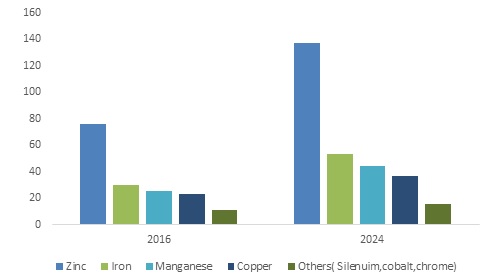Animal feed organic trace minerals market to witness lucrative growth with rising global meat consumption
Published: February 23, 2018
By: https://www.gminsights.com/industry-analysis/animal-feed-organic-trace-minerals-market
Animal feed organic trace minerals market demand is depicting a rapid expansion rate as these minerals are used in animal feeds to enhance bioavailability and increase the gut absorption. The organic trace minerals assist in activating essential enzymes and hormones which proves vital for livestock’s metabolic processes. Rising consumption of meat, poultry, and dairy products has given a considerable push to the global animal feed organic trace minerals market size. As per statistics, globally, 75 pounds of meat is consumed per person on an annual basis. Animal feed organic trace minerals industry is likely to garner profits from escalating meat production demand in India, China, and South Asia. Australia is consuming highest meat of about 198.87 lb/per capita, trailed by the U.S. and Argentina. As per a report by Global Market Insights, Inc., animal feed organic trace minerals market is expected to record a CAGR of 6.5% over the period of 2017-2024.

Europe dominates the overall animal feed organic trace minerals market with a target revenue of USD 280 million by 2024. The meat production demand, owing to increasing consumption of protein food is expected to favor the regional market growth. Asia Pacific animal feed organic trace minerals market is anticipated to observe highest gains of 7.5% between 2017-2024, led by the emerging economies such as India and China. This region is also one of the largest consumers of meat and accounted for 65% of overall animal feed organic trace minerals industry share in 2015. As per sources, an average Chinese person ingests 60 kg of meat every year. The ever-evolving Chinese population obtain 10% of calories from animal products such as eggs, meat, and dairy products. This has resulted in a greater demand for animal feed organic trace minerals market. Rising awareness toward ruminant health has led to a surge in adopting organic animal feed. The overall ruminant market is projected to account over USD 300 million by 2024. The growth of the regional animal feed additives market is also worth noticing, which is supported by strong economic outlook and rapid urbanization.
Based on type of minerals, animal feed organic trace minerals industry is segmented into iron, copper, zinc, and manganese. These minerals serve as vital ingredients in livestock fodder which helps in improving the immunity, lactation, reproduction, and strength in animals. Iron is one of the important micronutrient minerals which aids digestion in ruminants. Iron accounted for 17% of the overall animal feed organic trace minerals industry in 2016 and is followed by zinc, which collected USD 230 million in 2016.
These organic minerals when fed to the livestock, helps in improving the overall health of the animal and helps in making meat more nutritious. High product consumption in ruminants has stimulated animal feed organic trace minerals market to chart a lucrative growth in the coming years, as ruminant’s account for a chunk of the overall industry share. The poultry market is also witnessing heavy demand, owing to increasing domestic meat consumption, particularly in Vietnam Japan, Cuba, South Africa, UAE and Saudi Arabia. The global animal feed organic trace minerals market from poultry is set to register a CAGR of 7% over the period of 2016-2024.
This industry is administered by several regulatory bodies with strict standards pertaining to the product usage. The minerals and micronutrient elements used in livestock fodder compulsorily needs to undergo a stringent approval standard & process test set by the EU, FDA, and EFSA. U.S. has witnessed a substantial rise in animal feed organic trace minerals market, owing to such strict environmental regulations imposed by the governments.
Prominent animal feed organic trace minerals industry players include ADM, Royal DSM, Novus International Pancosma, Biochem, Tanke Biosciences Corp., QualiTech Corp, and Kemin Industries Limited.
Source
https://www.gminsights.com/industry-analysis/animal-feed-organic-trace-minerals-marketRelated topics:
Authors:
Global Market Insights Inc.
Recommend
Comment
Share
8 de marzo de 2018
Dear All,
How are you! I do agree with Aziz Sacranie that Alltech is the leader in regards to producing quality organic trace minerals for meat production. I have series of research during my PhD program using Bioplex Minerals especially Bioplex Zn for growth development, tissue mineral content and carcass quality of chicken particularly skin quality of the chicken. Some of our research findings already published in Avian Biology research, British Poultry Science and Biological Trace Element Research Journals. I do believe, that publication are informative and helpful for the researchers as well as for the industry.
Have a great day!
Dr. Salim, Bangladesh
Recommend
Reply
Alltech
8 de marzo de 2018
You have not mentioned the most prominent producers of organic minerals. Alltech, producers of Bioplex minerals are leaders in this field. their most recent research on stability constant for organic minerals helps the nutritionist to differentiate the various organic minerals in the market.
Recommend
Reply
Recommend
Reply
3 de mayo de 2018
It is a good and informative article.
The dose of products plays an important role in the growth of the birds. The dose is not clear as far as Organic minerals are concerned.
Recommend
Reply
Recommend
Reply
Técnica Mineral Pecuaria
6 de marzo de 2018
And Zinpro, Global Animal Products, what happened?
Regards.
Recommend
Reply
Recommend
Reply

Would you like to discuss another topic? Create a new post to engage with experts in the community.


















